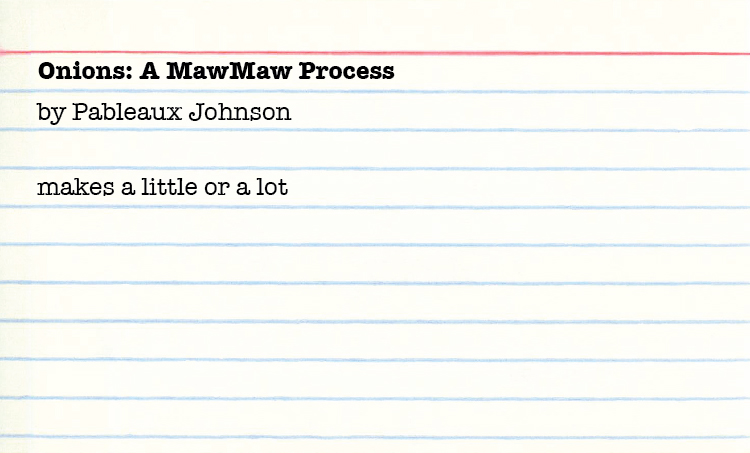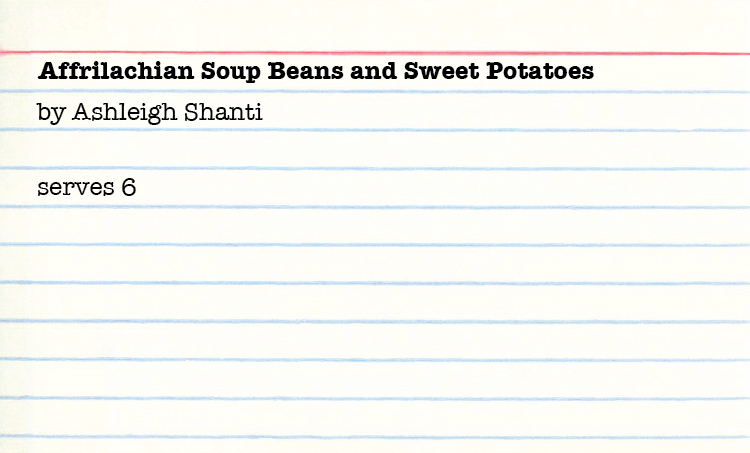We asked some of our friends and former contributors what they’ve been cooking from the cupboard during this time of self-isolation and limited grocery runs. Below, find three recipes that rely on pantry staples and that call on the comforts of home and family traditions.
Biscuit Church
by April McGreger
Sundays have always been a special day for me. Sure, in my Southern Baptist Mississippi household, Sundays were for church, but that was not it. Sundays were for pulling the family together around the table. Sundays were for grandparents. Sundays were for mom and dad in the kitchen. Sundays were for biscuits.
Throughout my childhood, my siblings and I were roused on Sunday mornings by the heavy and sweet aroma of bacon wafting down the hallway. Only after we’d stumbled toward the kitchen table would the funk of steaming buttermilk reveal itself. I rarely saw my mother make biscuits. They were more often than not in the oven by the time I made it to the kitchen, but I saw her Tupperware rolling mat smeared with sticky dough and her dented copper biscuit cutter. She usually had her back to this mess, now stashed in the kitchen sink, as she stood, with one hand on her hip, stirring the gravy with her flat-tipped wire whisk. She would immediately direct me to set the table or pour the juice or carry various accoutrements to the table. My dad manned the griddle, asking each of us how many eggs we wanted, as he spooned hot bacon grease over the yolks to set them to the perfect slow ooze.
These were the comforts that I craved when I invited all my friends and family for virtual biscuit-making on Facebook Live last Saturday night. Since the quarantine began, I find myself returning to the kitchen over and over. It is a place where I have the most feeling of control. It is where I stand, feet firmly planted at the island, to steer this ship. I conjure comforts and conviviality, past and present. And I see, now more than ever, how the kitchen can empower others as well. The art of Making Do. The science of household management, taking stock of the what’s-in-the-pantry and how we can turn that into the most possible joy, nourishment, and comfort for the whole family. Gather your ingredients and get started. Substitutions welcome.

Ingredients
2 cups pastry or all-purpose flour (or whole wheat, rye, or oat flours; you can sub self-rising flour but then omit the baking powder and salt), plus more for rolling
2 teaspoons baking powder
1 teaspoon salt
1 stick plus 2 tablespoons cold butter (or shortnening, lard, or schmaltz); 1 stick cut into cubes and chilled, 2 tablespoons melted
3/4–1 cup buttermilk (or milk with a teaspoon of lemon juice or vinegar, or yogurt thinned with a tablespoon or two of water)
Directions
Preheat the oven to 450°. Lightly butter a light-colored baking sheet.
In a large bowl, combine the 2 cups of flour with the baking powder and salt. Using a pastry blender or food processor, cut in the cubed butter until the butter is the size of peas. Add the buttermilk and stir with a wooden spoon until a soft dough forms. Turn the dough out onto a lightly floured work surface and knead 2 or 3 times, just until it comes together.
Using a lightly floured rolling pin, roll out the dough ¾ inch thick. Fold the dough in half, press or roll back out, then turn a quarter of a turn and repeat 3 more times. Using a lightly floured 2 1/4-inch round cutter, stamp out biscuits as close together as possible. Pat the dough scraps together and stamp out more biscuits. Transfer the biscuits to a large baking sheet. Bake for about 8-15 minutes, until the biscuits are risen and deep golden. Brush the hot biscuits with the melted butter and serve them hot or at room temperature.
Caramelized Onions: Sizzle Therapy and MMO
by Pableaux Johnson
On a normal day in my house, any cooking project starts with the smell of onions sizzling in my trusty sauté pan. Thin white strips and tiny cubes hit super-heated steel with a muffled hiss, then, after a few seconds, give off a distinctive, familiar aroma that represents tangible progress.
The end product might be any one of the high-volume “grandma food” classics—Monday-night red beans and rice, savory turkey bone gumbo, or a tasty marinara “utility sauce”—but they all start with a few chopped onions in a hot, heavy-bottomed pot. Going from eye-wateringly aggressive to caramelized perfection. Sweet, complex, and transcendently delicious.
But as we all know, now are not normal times. In these current days of COVID-related “shelter in place” orders and disruptive uncertainty, so many folks are turning to the stove to process. They’re trying their hand at bread or biscuit baking (see above) or classic cakes they remember from their childhoods or deeper family legend. Kitchen time helps feed families, roommates, or friends. Kitchen time can pull focus on the present—to a clear list of ingredients and steps—and that results in something both satisfying and centering (and hopefully delicious).
I come from a big family within a big family that believes in gathering at the table whenever possible, which leads to one of the Hebert family trademarks—a distinct lack of culinary scale. In my kitchen, it’s no trouble to feed twenty-five people on two-hour’s notice, but cooking a light meal for two? Just not in the skill set.
When New Orleans went on functional lockdown in early March, I felt that I might need to emotionally process through cooking, so I did my hunker-down grocery run at the local restaurant-supply warehouse (as one does). The first items on the flatbed cart were wax mesh sacks filled with standard-issue yellow onions—100 pounds worth—which for me represents a solid investment in mental health and a hedge against whatever is coming in days ahead.
In that first week, I kicked into what can only be described as MawMaw Maximum Overdrive (MMO), in which I chopped, sizzled, and cooked down 75 pounds of the initial 100 and packed a freezerful of caramelized goodness. Every part of it—from chopping through the tears to wrangling two double-burner Magnalite roasters set to “retro rocket level 11”—felt good. Not always comfortable in a tiny-ass kitchen, but just what I needed. What’ll it become? Just about anything delicious, in massive, massive quantities.
You’re a normal person. Go make a (regular-sized) batch. See if it helps. Then as the days go by, see if overdrive kicks in. It affords a little certainty right when you need it, and it just might help.

Directions
Mince a couple of medium-sized onions into fine cubes. Preheat a heavy-bottomed pot or sauce pan for a few minutes, then add onions and a couple solid plugs of cooking oil (vegetable, canola, olive, whatever you have). Hit them with a little salt and pepper. Reduce heat to medium/medium-low and stir every once and again.
Over the course of 20 or so minutes, the onions will go from white to clear to golden to brownish. (The darker you get the onions without burning, the better.) The longer your onions stay on the heat, the more they change. After a few minutes on the stove, they reach the first cooked stage—translucent. As the juices start to steam out, the onion chunks go limp as their cell walls break down.
Add more time and the “lazy” onions start to change color—first to a pale yellow (golden), a light tan (browned) and eventually to a deep, mahogany brown (caramelized). In this process, the juices and sugars in the onion start to cook, getting mellower and sweeter with every shade of brown. The Holy Grail is a deep mahogany paste with an impossibly complex flavor that can make the angels weep.
Right beyond perfection, of course, is burnt. So watch yourself.
Affrilachian Soup Beans and Sweet Potatoes
by Ashleigh Shanti
An enduring symbol of the humility and struggle of our region, soup beans have long served as a comforting staple for most folks in Western North Carolina. Each batch is served up with the chef’s own unique spin—some topped with diced white onion, some with crumbled cornbread; and those from staunch pinto bean purist families with nothing more.
When my family settled in the Appalachian Mountains of Southwestern Virginia four generations ago, they sought a sense of familiarity. Soup beans provided just that. My Grandma Hattie Mae had comfort in mind when marrying two traditional staples from two incredibly different parts of the globe—soup beans from Appalachia and the more familiar bean porridge, Ewa Oloyin, from West Africa. In a nod to her West African heritage, she’d top each bowl with crispy sweet potatoes, which were much more widely available than the traditional fried plantains. My version is nearly identical to what she’d put on the table.
Her version was also chock-full of “fillers” like greens and tomatoes, unlike traditional soup beans. Making dinner stretch was Grandma Hattie Mae’s specialty and this recipe does just that.

Ingredients
1 cup blackeye peas, soaked
1 cup butterbeans, soaked
3 bunches of greens, chopped (turnip, mustard, etc)
2 yellow onions, split
1 smoked ham hock or ham neck bone
1 can diced tomatoes
1.5 tsp paprika
4 sweet potatoes, diced
Kosher salt
cracked black pepper
Directions
For the sweet potatoes:
Preheat oven to 400. Toss sweet potatoes in olive oil to coat and spread on a sheet tray. Roast in oven for 30 minutes, until potatoes are fork tender yet crispy. Salt to taste, set aside.
For the beans:
To a large stockpot add beans, greens, ham hock, onions, and enough cold water to cover by 2.5 inches. Bring pot to a boil for a full minute, then lower heat to simmer. Cook beans for an hour, stirring occasionally and adding more water to ensure beans are fully covered (if necessary).
After an hour of cooking, do the bean test. Take a blackeyed pea and butterbean and pop them in your mouth. If you can effortlessly smash the bean to the roof using your tongue, they are done. If not, cook beans for 30 minutes more, until creamy.
Once beans are fully cooked, stir in tomatoes, paprika, and 2 tsp salt.
To serve:
Ladle soup beans in individual bowls, finish with a heaping spoonful of sweet potatoes and cracked black pepper.
Previously a geology scholar, April McGreger found her way into the professional kitchen by way of making pastries at Chapel Hill’s Lantern Restaurant. Following several years as pastry chef, April returned to her culinary roots of pickling, preserving, and bringing to market seasonal and local farm-driven food under the Farmer’s Daughter Brand. April grew up in a rural Mississippi sweet potato farm family and learned the traditional art of preserving and baking at the elbow of her mother and grandmother. She is most well-known for her baked goods, southern-style preserves, chutneys, and lacto-fermented vegetables, including real sauerkraut and authentic kimchi and barrel-fermented, deli-style pickles. She is the author of Sweet Potatoes, a Savor the South cookbook from UNC Press.
Pableaux Johnson is a food/travel writer, photographer, and technologist based in New Orleans. Johnson is the author of three books (ESPN Gameday Gourmet, Eating New Orleans: From French Quarter Creole Dining to the Perfect Poboy, and Lonely Planet’s World Food New Orleans) as well as a contributor to the New York Times, Austin Chronicle, Saveur, Food and Wine, and Bon Appetit. Johnson’s photo essay “Forty Sundays A Year” appears in the Documentary Moment Issue of Southern Cultures.
Ashleigh Shanti is Chef de Cuisine of Benne on Eagle in Asheville, North Carolina. Working closely with Chef John Fleer, Ashleigh pays homage to the rich African-American culinary traditions that once thrived in The Block–the neighborhood surrounding the restaurant–as well as honoring her own history as a southern, African American woman. Born in St. Mary’s, Georgia, and raised in Virginia Beach, Virginia, Ashleigh’s culinary journey has taken her everywhere from the Southern Food and Beverage Museum in New Orleans, to Blue Hill at Stone Barns in upstate New York, to Kinston, North Carolina, where she worked as Culinary Assistant to Vivian Howard at Chef and the Farmer. In Fall 2018, she moved to Asheville to help Chef John Fleer open Benne on Eagle.

